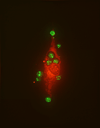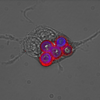Fungal killing by mammalian phagocytic cells
- PMID: 18573683
- PMCID: PMC2563425
- DOI: 10.1016/j.mib.2008.05.011
Fungal killing by mammalian phagocytic cells
Abstract
Phagocytes are considered the most important effector cells in the immune response against fungal infections. To exert their role, they must recognize the invading fungi, internalise, and kill them within the phagosome. Major advances in the field have elucidated the roles of pattern-recognition receptors in the innate immunity sensing and the importance of reactive oxygen and nitrogen species in intracellular killing of fungi. Surprising exit mechanisms for intracellular pathogens and extracellular traps have also been discovered. These and several other recent breakthroughs in our understanding of the mechanisms used by phagocytes to kill fungal pathogens are reviewed in this work.
Figures


References
-
- Romani L. Immunity to fungal infections. Nat Rev Immunol. 2004;4:1–23. - PubMed
-
- Nathan C. Neutrophils and immunity: challenges and opportunities. Nat Rev Immunol. 2006;6:173–182. - PubMed
-
- Netea MG, Brown GD, Kullberg BJ, Gow NA. An integrated model of the recognition of Candida albicans by the innate immune system. Nat Rev Microbiol. 2008;6:67–78. - PubMed
-
- Goodridge HS, Simmons RM, Underhill DM. Dectin-1 stimulation by Candida albicans yeast or zymosan triggers NFAT activation in macrophages and dendritic cells. J Immunol. 2007;178:3107–3115. - PubMed
Publication types
MeSH terms
Substances
Grants and funding
LinkOut - more resources
Full Text Sources
Medical

